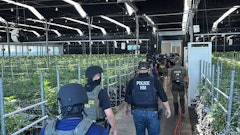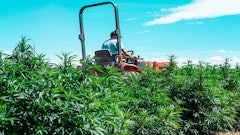

Talk about reaping the maximum profit potential sometimes takes a back seat to cultivation and compliance issues that plague cultivators regularly. Maximizing yield is often thought of as the holy grail of cultivation, but increasing yield isn’t the only way to increase profits. And, in fact, if you increase yield, but simultaneously increase production costs, your profits may not budge.
Increasing profit margins, however, are increasingly important as wholesale cannabis prices continue to decline. (Editor’s note: See the spot price chart on page 14.) There’s no magic-wand approach to making a cultivation business more profitable, but members of the industry are finding several common tactics.
1. Optimize Floor Space, and Track Yield and Costs
Grow sites cost money, so it makes sense that businesses want to efficiently use space for which they are already paying fixed costs like rent .
Vertical cultivation is one method some cultivators are employing as they aim to maximize the space they have, especially in states with canopy square-footage limits.
Adam Hudgins of Colorado’s Best implemented a vertical cultivation system and doubled its plant count “without buying one more square inch of real estate,” Hudgins told Cannabis Business Times in a recent interview.
Precision Cultivation Company CEO Jim Ott, who has 35 years of non-cannabis agribusiness experience, says it’s important to find the correct crop density for a specific strain or purpose. If you’re growing for flowers, for example, smaller plants are better than trees, he says.
“When you begin to work with tighter plant density, your nutrient requirements are less, you can utilize labor better, you can more easily cycle plants so your harvest can [be continuous],” says Ott, whose company focuses on plant genetics and building a network of well-run cultivation facilities. “If you’re making it like a manufacturing [facility], in terms of your workflow, those are ways to bring some efficiencies.”
Ott says growers also should transition away from using traditional measurements like pounds per bulb and focus on comprehensive calculations like cost per square foot.
“Some of those old-school measurements are highly inefficient,” he says. “They’re there because that’s how it was done before, but that’s not how nursery agriculture measures success.”
Hadley Ford, a former Goldman Sachs banker who co-founded the investment firm iAnthus Capital, agrees optimization of space is significant and says many growers focus more on quality and yield than on metrics important to investors.
“You’d be surprised,” he says. “You go in and say, ‘What’s your variable cost for a gram of cannabis?’ and [many growers] say, ‘I don’t know what that means.’”
Ford says, “... It comes down to one thing: cost. ... [And] the last thing you want is to spend a lot of money on a building and equipment and have the guy go out of business.”
iAnthus has invested so far in four states, including with businesses run by Ford’s siblings in Vermont and New Mexico, a forthcoming operation in Massachusetts and an existing business in Colorado. The firm buys property and machinery, giving cultivators an infusion of capital, and leases them back to the cultivators.
Ford envisions cost-savings by optimizing space and machinery used in iAnthus-owned properties. The Colorado grow location is only using 60 percent of its space, he says, and future partners might be able to ensure full property utilization or savings from sharing use of processing machinery.
Ott cautions that businesses looking to join forces to cut costs would be well-advised to abide by similar biosecurity practices to avoid risks.
2. Reduce Labor With Automation
“We often see cultivators using the same methods they used in a small-scale operation and just replicating it multiple times in a larger space,” says Diane Czarkowski, founding partner at consultancy Canna Advisors. “For example, many operations that we’ve seen in indoor facilities build several small rooms and still tend to the plants manually — going from room to room. Production-level cultivation operations should be treated like any other horticulture operation: Ideally it’s built in a greenhouse, but also that the processes are automated as much as possible,” she says.
“Labor is one of the greatest expenses, and if you are hand watering, manually moving the plants around, repotting, trimming, adding nutrients, packaging, etc., it all adds up. All of those things can be automated,” Czarkowski says.
David Holmes, co-founder, CEO and Chief Science Officer for Clade9 — which works with cultivation businesses to develop scientifically proven systems for commercial-scale cannabis cultivation — lists automated irrigation setups among the top areas where cultivators can cut costs and increase profitability.
A fertigation system automatically injects nutrients into your hydroponic grow, again eliminating manual labor.
In addition to a lift that enables easier access to the vertical tiers of plants for the tech that works in each grow room, thus minimizing labor demands, Colorado’s Best also automated watering and feeding, said Hudgins. The combination of vertical grow and automation enabled labor costs to be reduced by two-thirds.
And as the industry matures with new regulated markets in agriculture-savvy California and Florida, borrowing automation technologies from non-cannabis plant applications will continue to drive savings, Ott predicts.
“This industry is going to evolve like every other plant industry,” he says. “[California opening regulated medical and recreational markets] will push the change fairly quick.”
3. Maximize Workflow Efficiencies
“Flow is also important. You have to design your facility according to the workflow,” says Czarkowski. “Many operations move into a building and don’t reconfigure the space, so they are inefficient.”
Though still a novel idea for cannabis, Surterra Holdings — a cultivator in Florida’s medical market — is looking at possible investment in a lift that will carry rows of plants ready for processing to a workstation to minimize labor, says Wes Conner, Surterra’s manager for special projects, who joined the company with an agribusiness resume and a family background in pecan farming. The company seeks to become the lowest-cost provider in Florida through scale.
Ott says some efficiencies may come when laws relax, anticipating significant industry-wide savings when large businesses emerge specializing in wholesale plant propagation.
If that happens, however, all businesses will be further pressed to cut costs and increase efficiencies wherever they can.
Maximizing employees’ efficiencies can help curb costs in hours worked or even the number of employees needed. Cultivators and industry consultants have offered, in previous interviews with Cannabis Business Times, several ways to help increase work efficiencies. First, walkie-talkies (or another means of communication) can save time walking from one end of what is often a large facility to another to speak with another employee or management.
Any ways to streamline workflow, no matter how small, can save nickels or dimes on the hour, but with x number of employees and 8,772.7 hours in a year, those nickels and dimes can add up.
“To maintain optimal growth environments, controls should be added to the mechanical HVAC, electrical system and plumbing system. “ -Kathleen Hokansen, Koan energy consultants
4. Update Your Facility
In addition to creating or updating floor plan designs to maximize workflow efficiencies, Holmes suggests cultivators design facilities or update them to reflect modern cultivation design. One example, says Holmes, is implementing preventative clean room technology.
Clean room technology helps to prevent pests from entering the grow environment, can save on other pest treatment measures and supplies, as well as on labor that needs to focus on addressing pest problems when they occur.
An ounce of prevention is worth, in this case, potentially millions of dollars if the clean room technology can prevent a pest outbreak that could destroy an entire crop.
5. It Takes Money to Earn Money
It’s an old saying and often is true. As cannabis businesses strive to scale to increase efficiencies and streamline processes, maximize yield to meet market demand or build highly automated, modern facilities, cashflow is often a hindrance, especially as the cannabis industry continues to be hamstrung by skittish U.S. banks.
Many cannabis businesses do have American investors, but Ford says he found Canadians far more comfortable with the industry and turned to them for much of iAnthus’ capital.
“If you’re financing yourself from cash-flow, it’s hard to grow faster than the market,” Ford says about the appeal of adding an investing partner.
Making your business attractive to investors requires professionalism, good market prospects and clean books, Ford says, as well as a basic understanding of business principles.
He says iAnthus invested with his brother’s New Mexico firm partially because of a trusting personal relationship, but also because of the company’s large market share and potential to grow.
In Vermont, he says, the state’s four-license medical oligopoly and anticipated near-term legalization of recreational sales had appeal. Massachusetts was appealing because of the prospect of a prime retail location, with a medical storefront expected to ultimately sell recreational product, he says.
In Colorado, Ford says, the owners’ professionalism and solid local market share offered confidence that investing with them would allow a foothold in the state.
6. Curb Energy Costs
A simple tactic to lower energy use is to make sure your equipment is appropriate to your site needs. “To maintain optimal growth environments, controls should be added to the mechanical HVAC, electrical system and plumbing system. Keep in mind that over- or under-sizing equipment can significantly affect energy efficiency, costs of production and cash flow,” wrote Kathleen Hokansen of Koan Energy Consultants in an article, “20 Ways to Cut Energy Use,” in Cannabis Business Times.
“For example, an oversized HVAC unit is more expensive and consumes more energy than smaller units, but it never has the opportunity to reach peak efficiency. Under-sizing causes premature wear-and-tear on the HVAC unit, and it may not perform as expected,” said Hokansen.
Some growers also say they avoid turning on all lights and equipment at one time, instead doing so in 15-minute intervals. “Since the consumer is charged for the highest 15-minute demand period during the billing cycle ..., growers can incur significantly higher fees,” explained Hokansen.
She also suggests growers know the hours of “peak demand” and minimize energy use during those hours. “Peak demand charges and rates occur when a large portion of customers need energy at the same time, resulting in the utility company charging more for the increased production, the strain on the grid’s infrastructure and maintenance—all of which are passed on to the consumer as higher demand (kW) fees,” Hokansen noted.
Another way to minimize peak demand charges, suggested Hokansen, is to “produce and store energy during off-peak hours for use during peak demand. ... Thermal- and battery-storage systems can produce electricity during off-peak hours for use during peak demand ...,” she said. “The storage technology’s low-power compressors operate by using the cool night air, when energy demand is at its lowest, to create and store energy. The next day, the storage unit takes over for the high-power compressors of commercial HVAC to cool the facility.”























